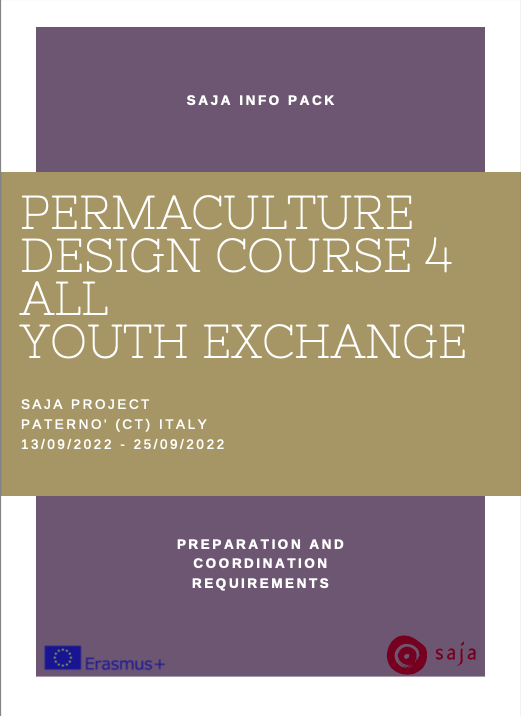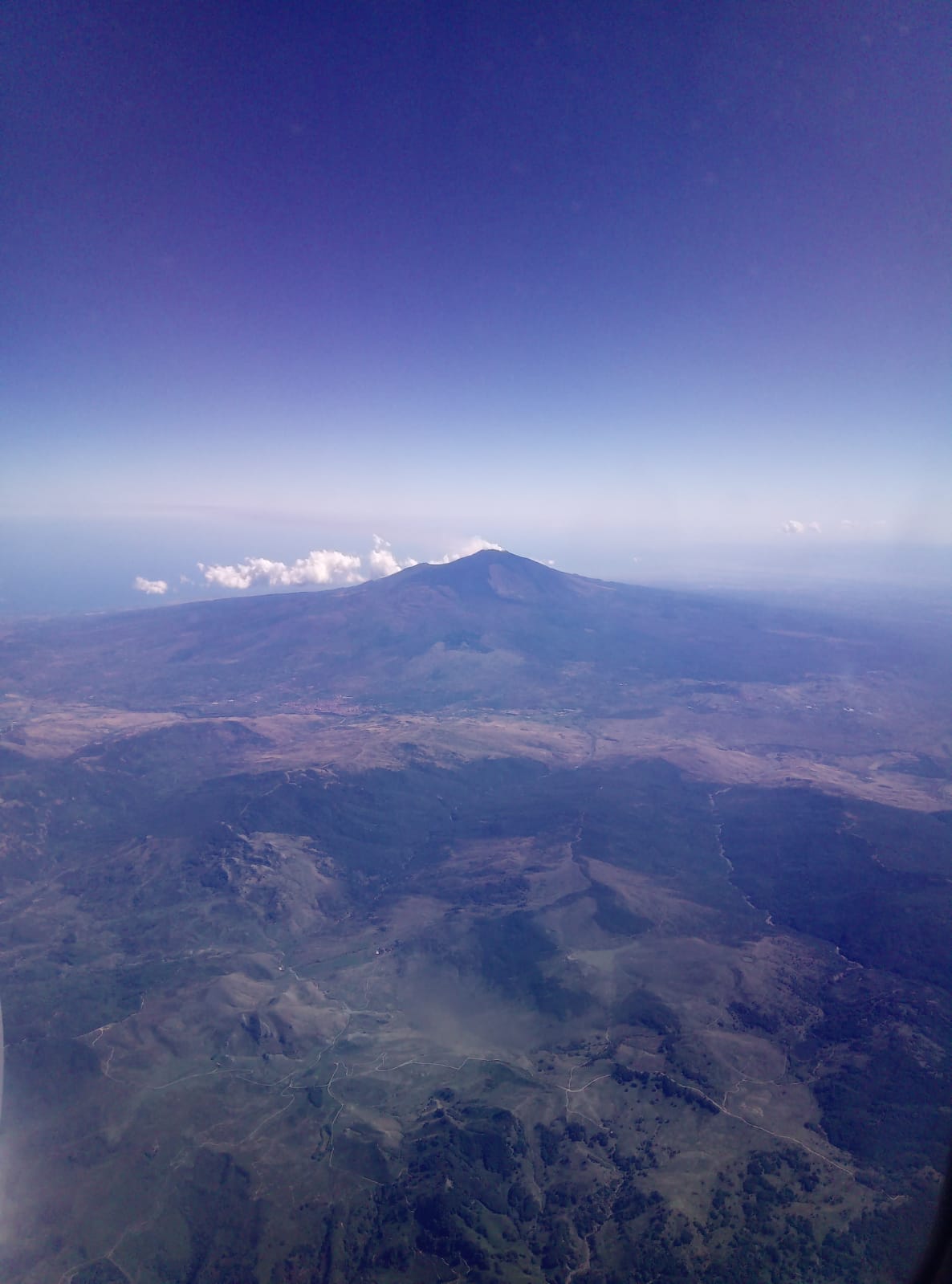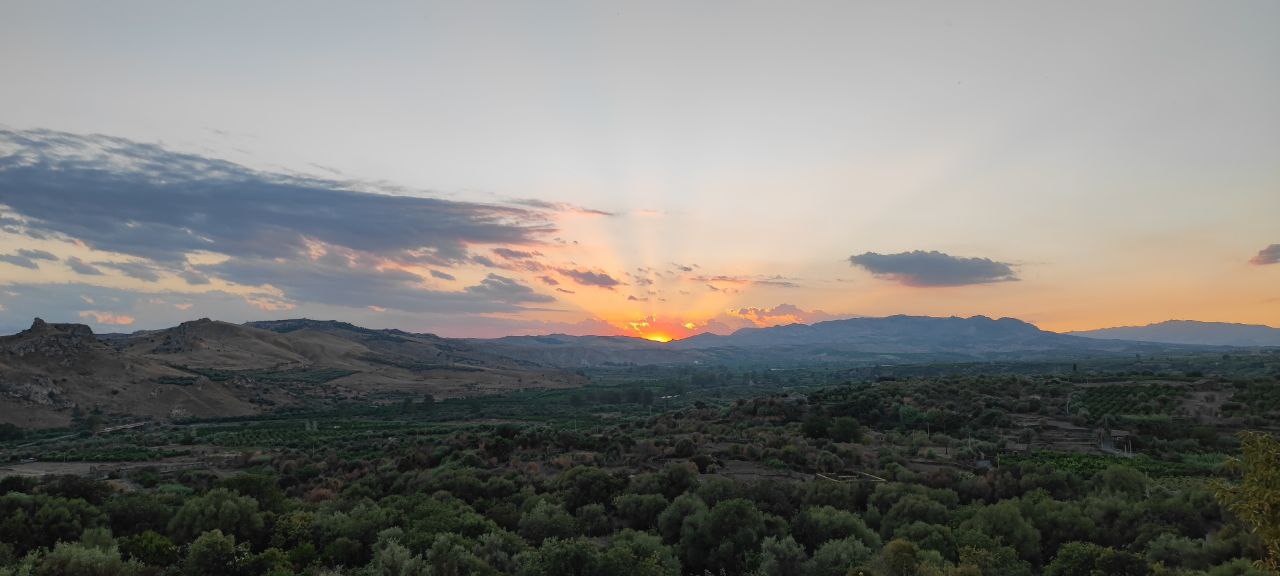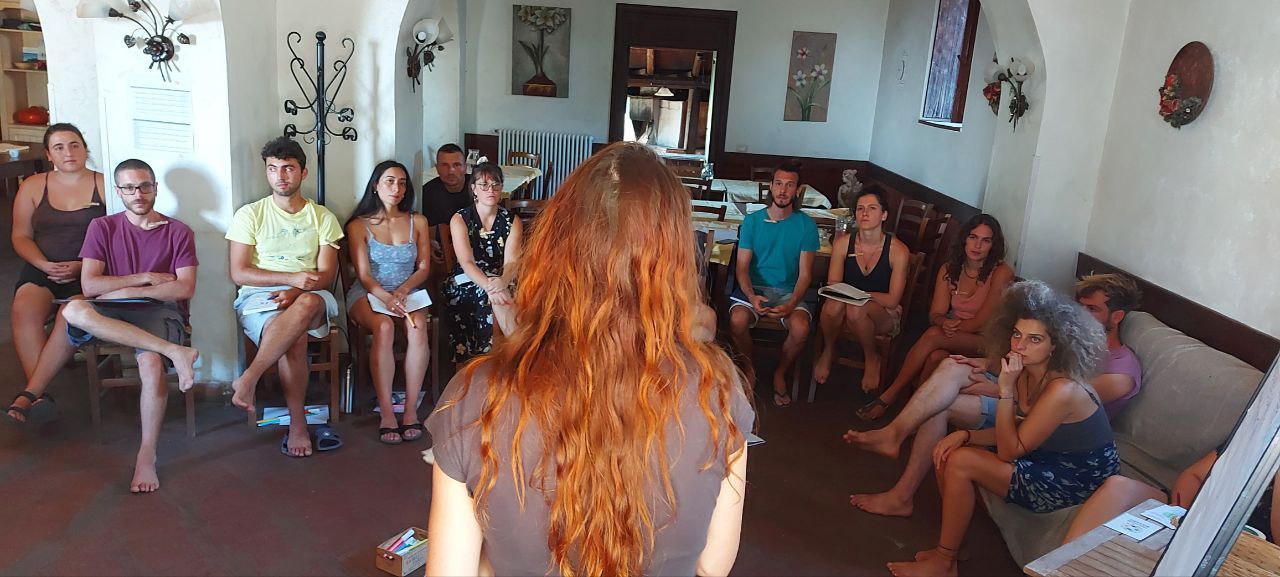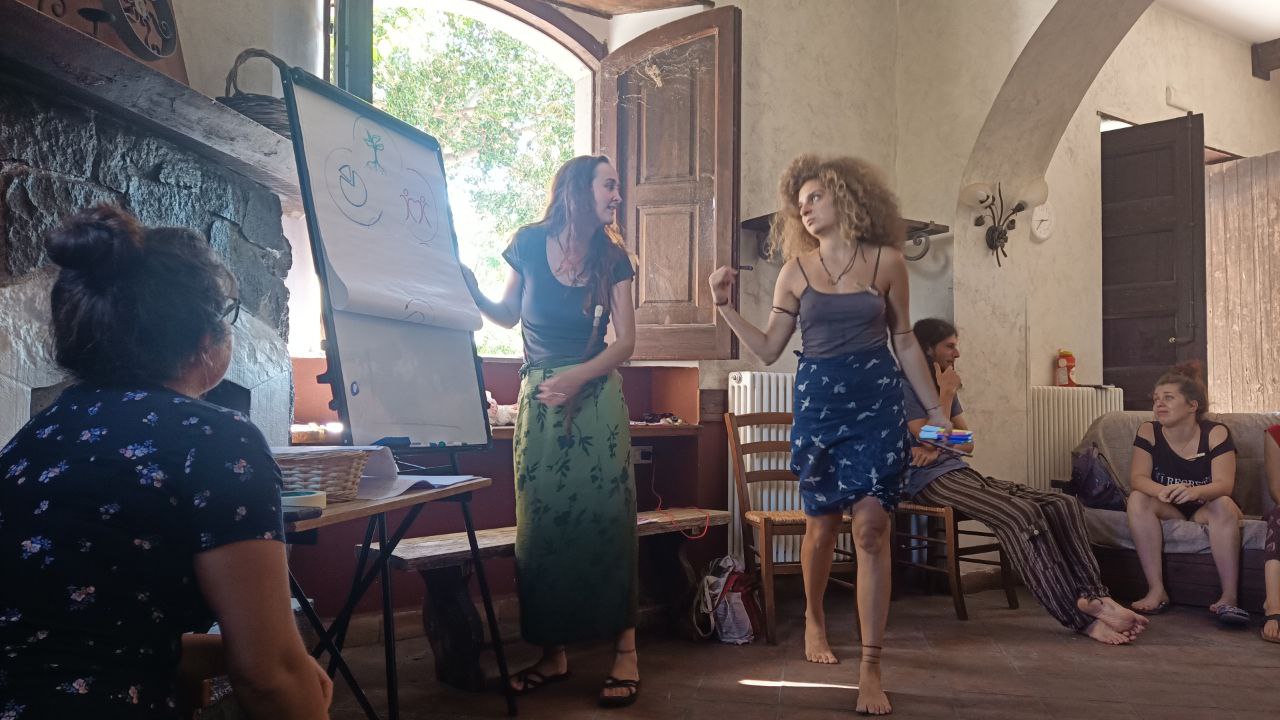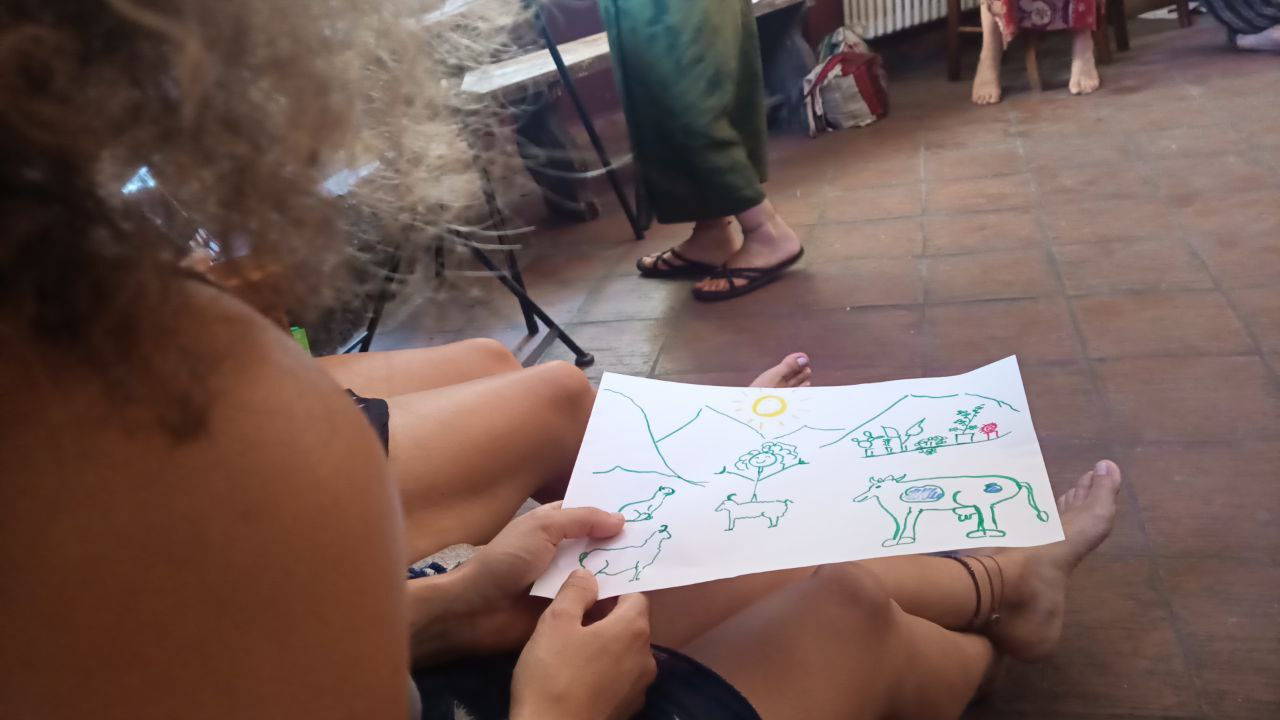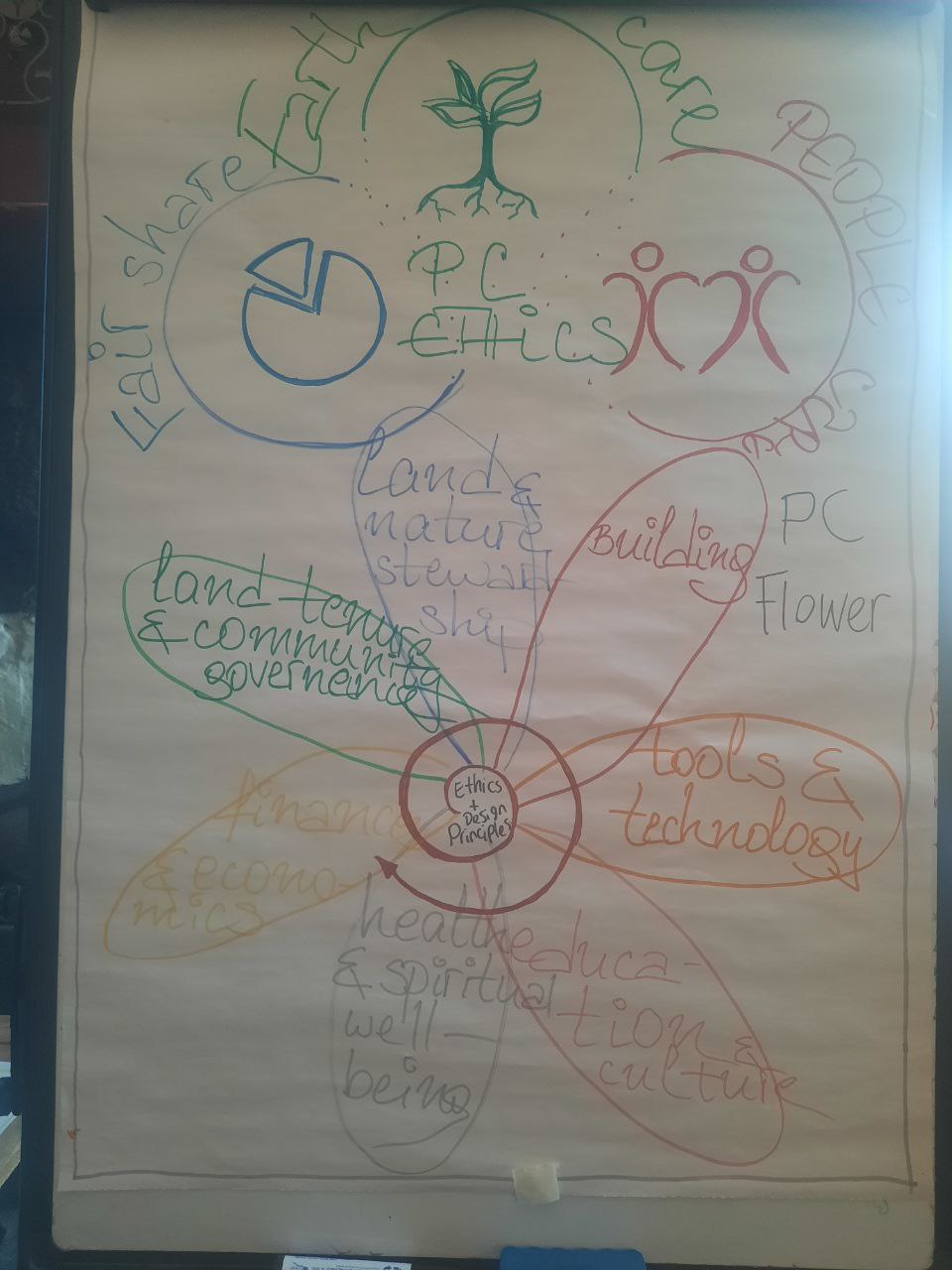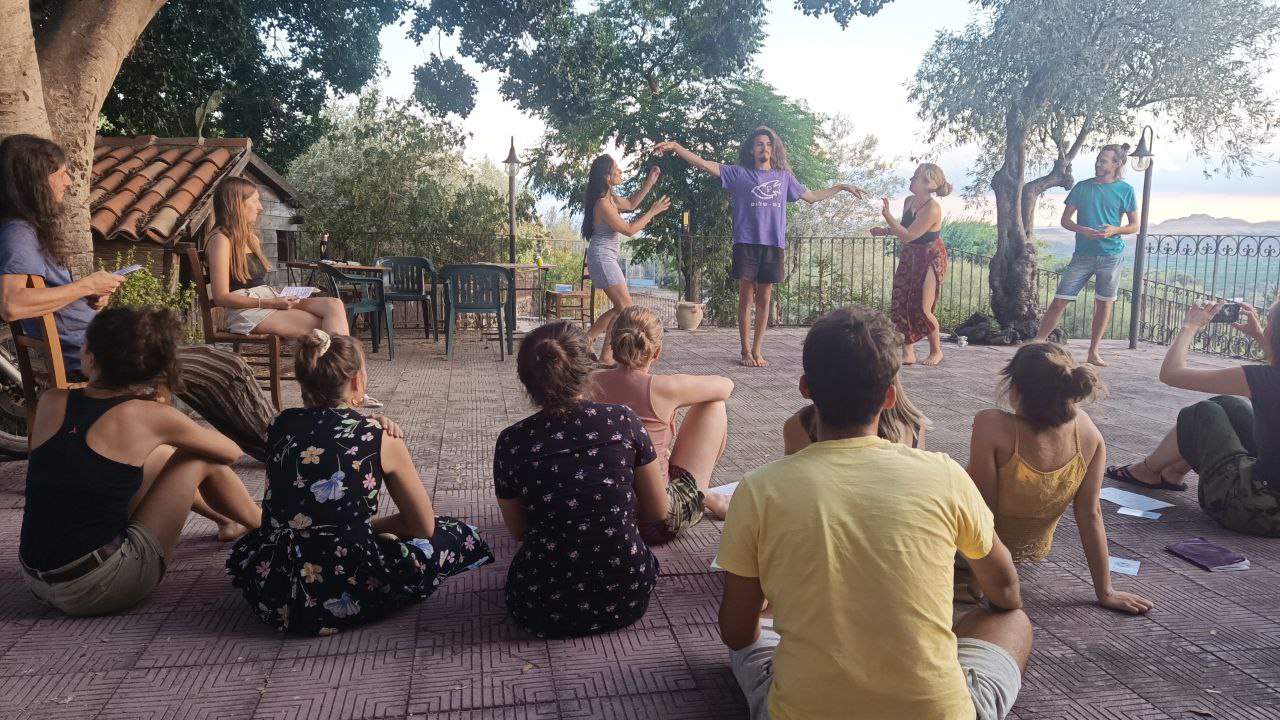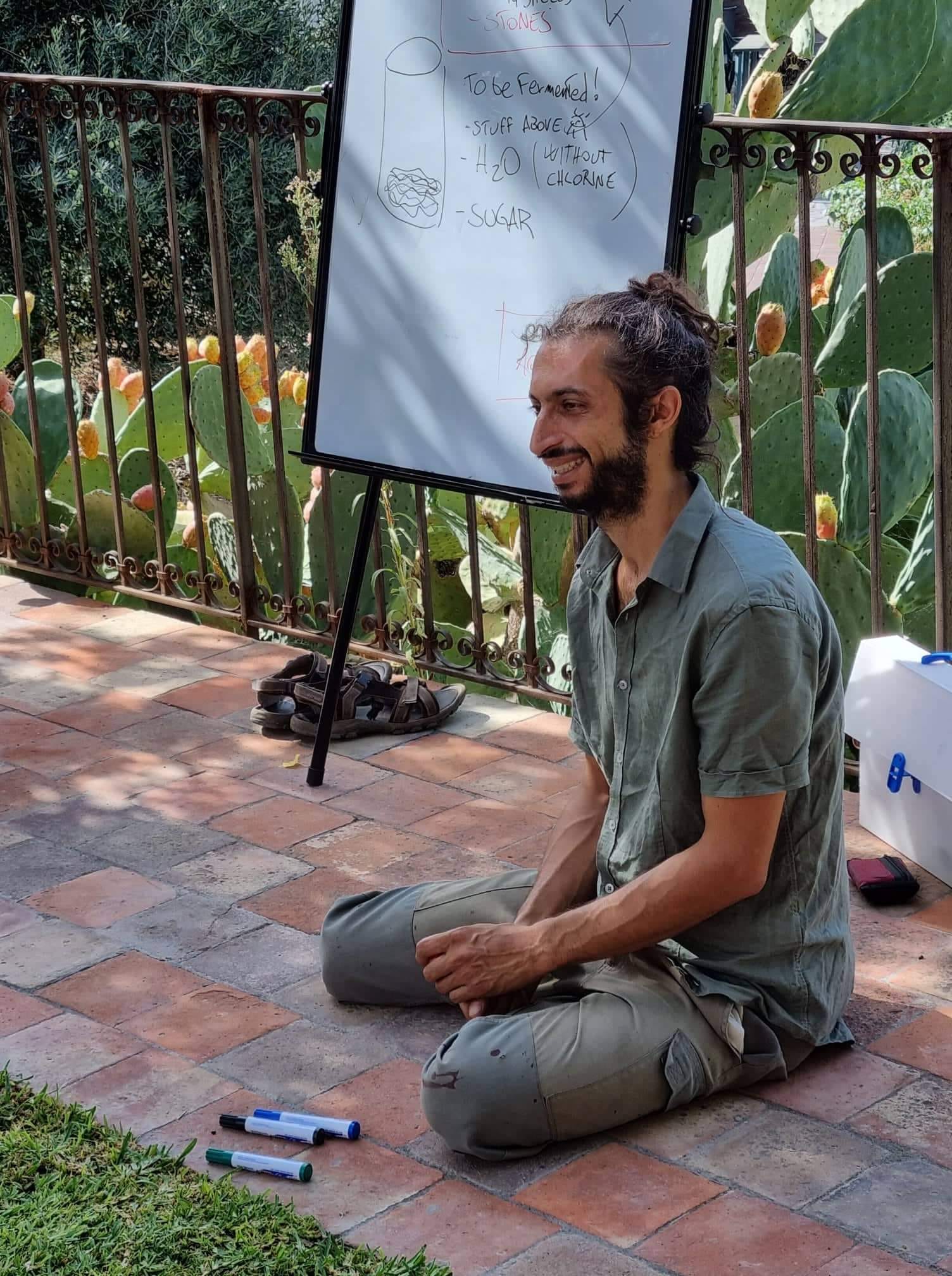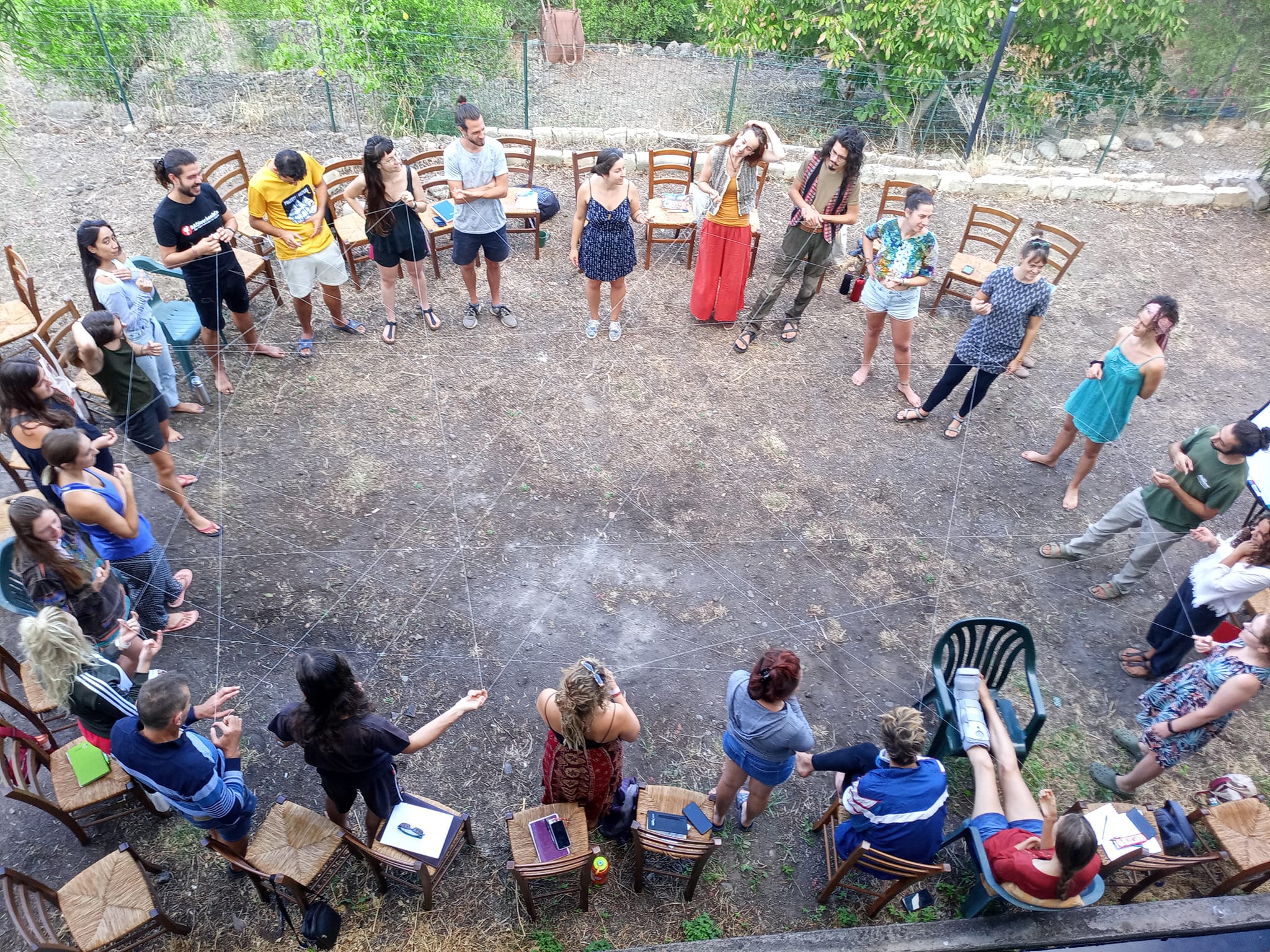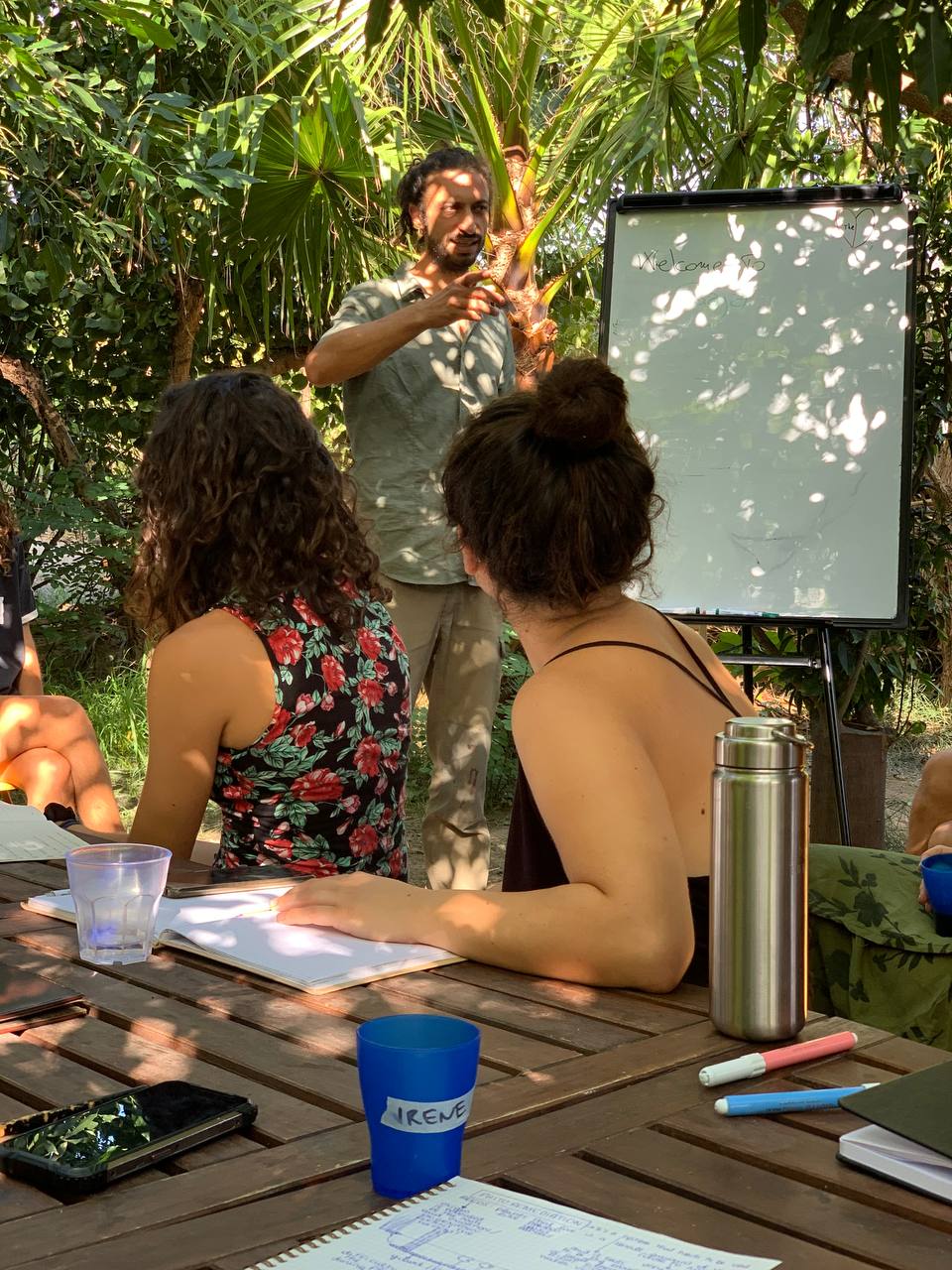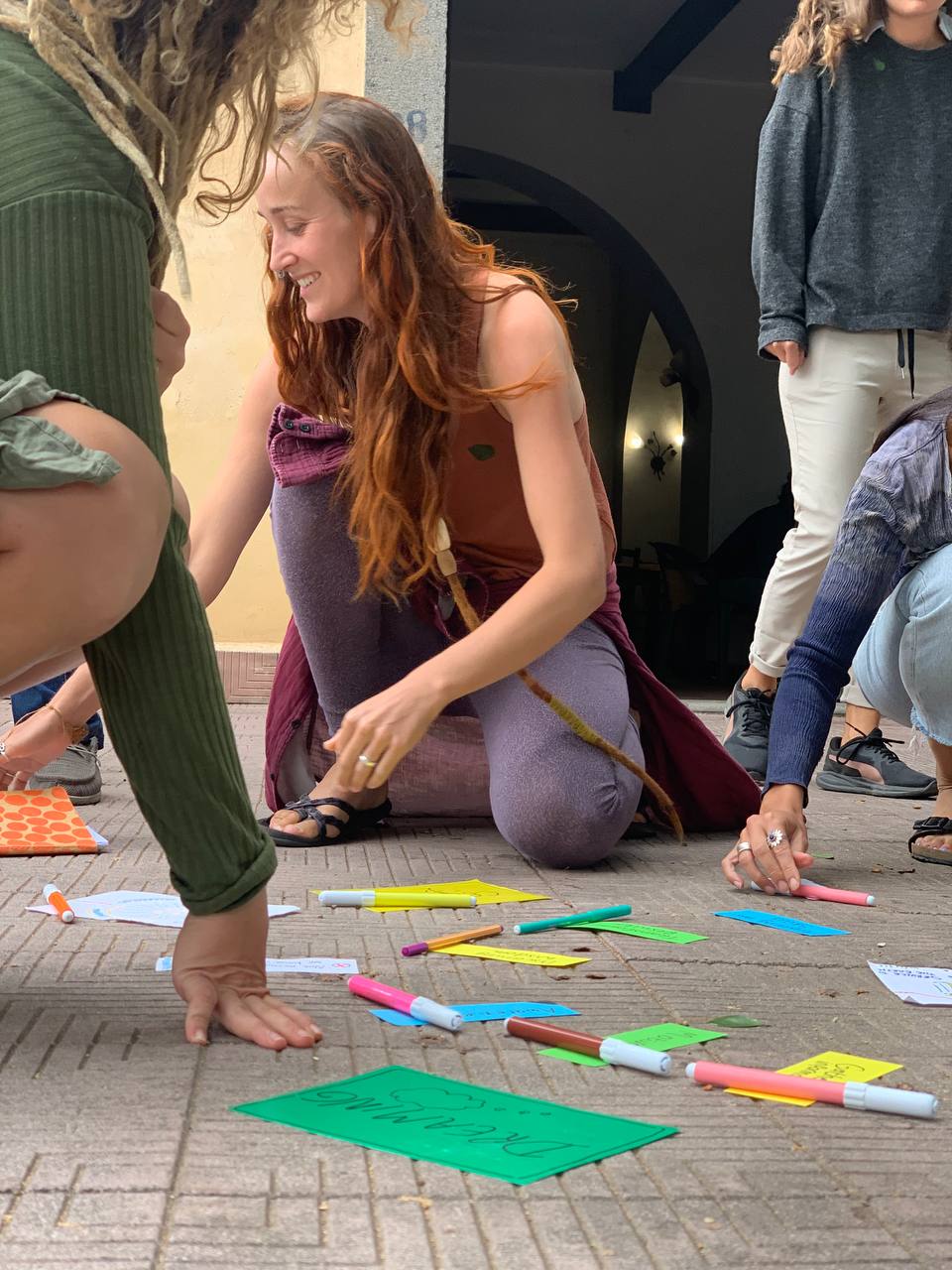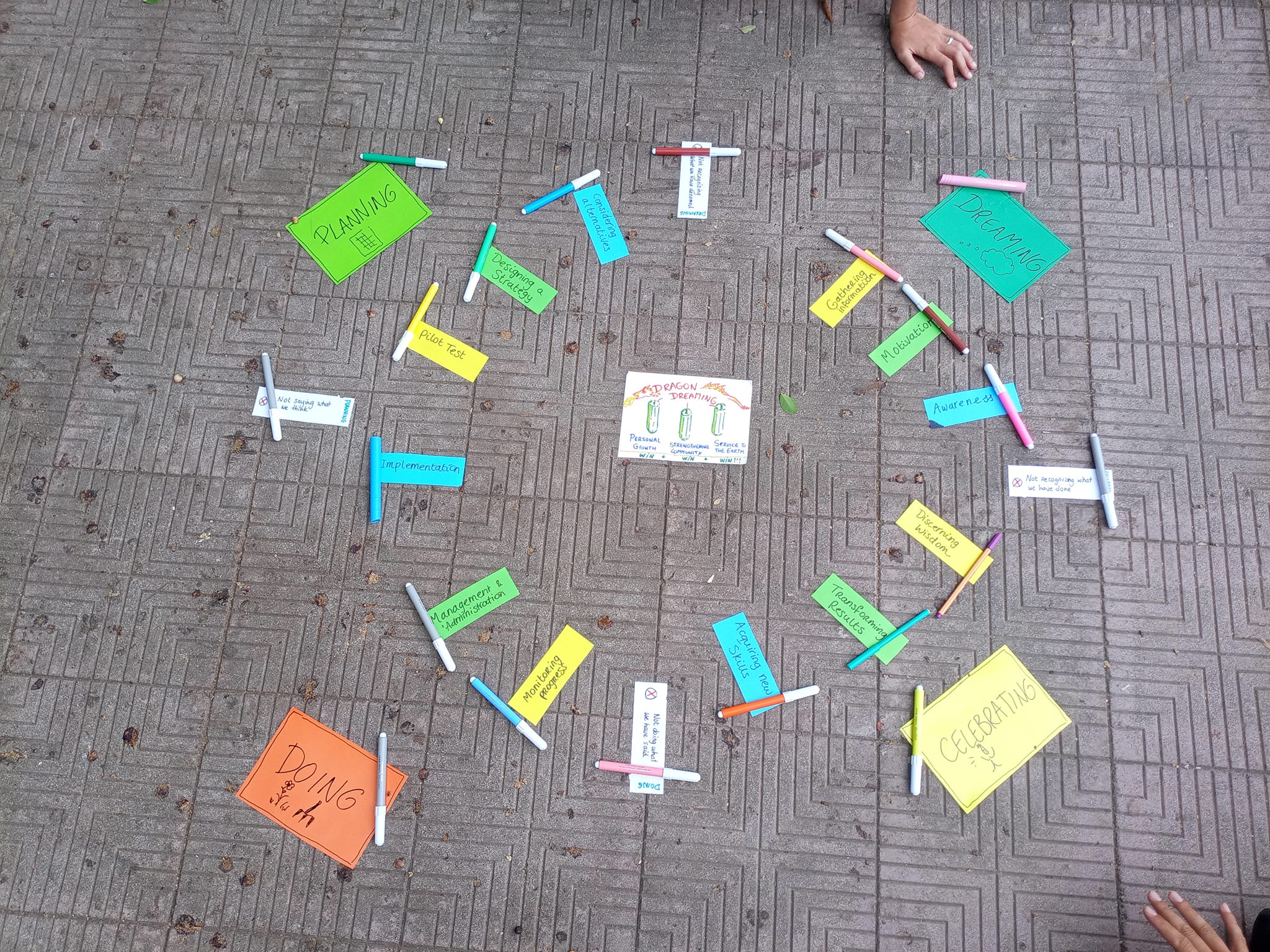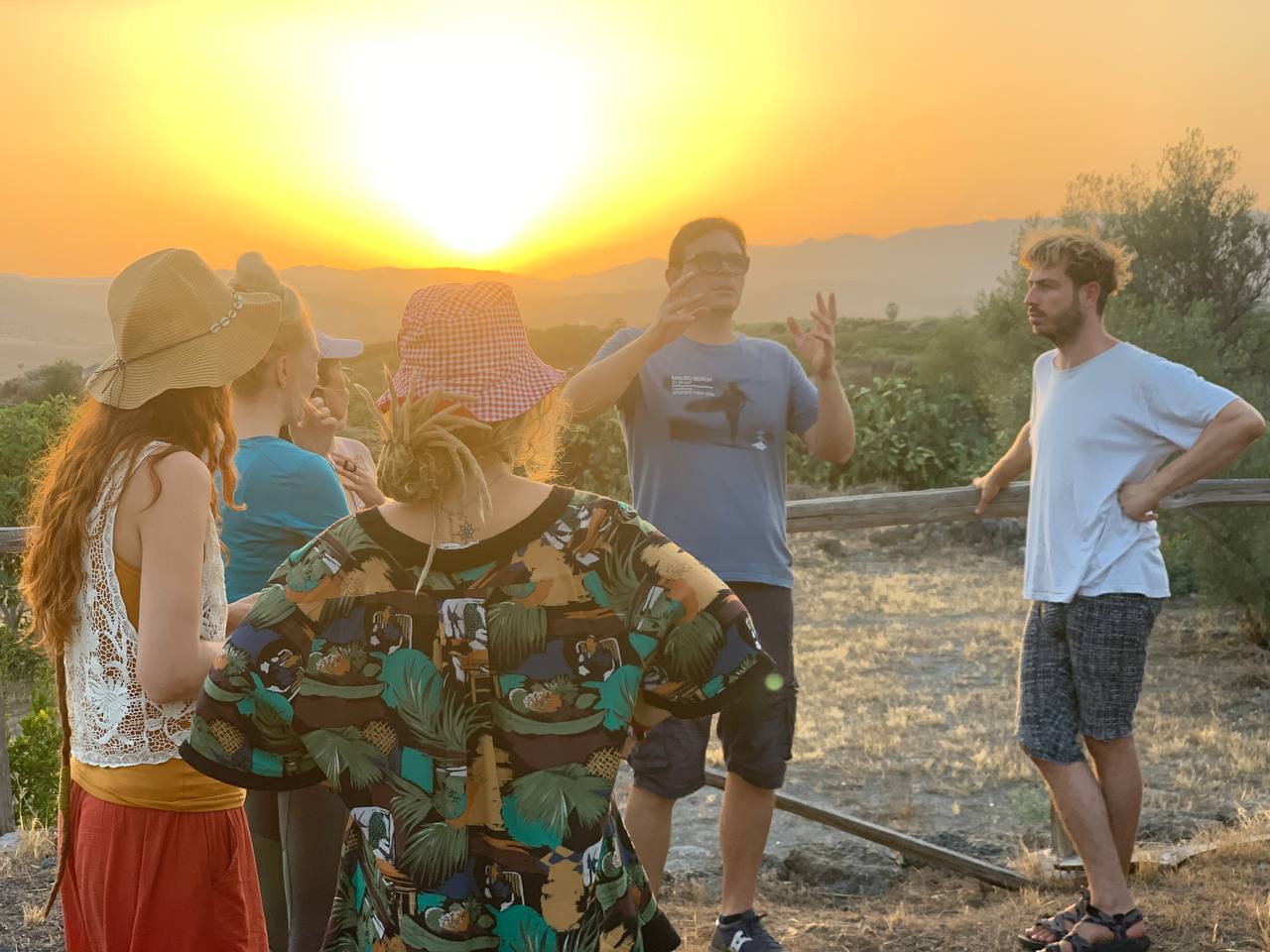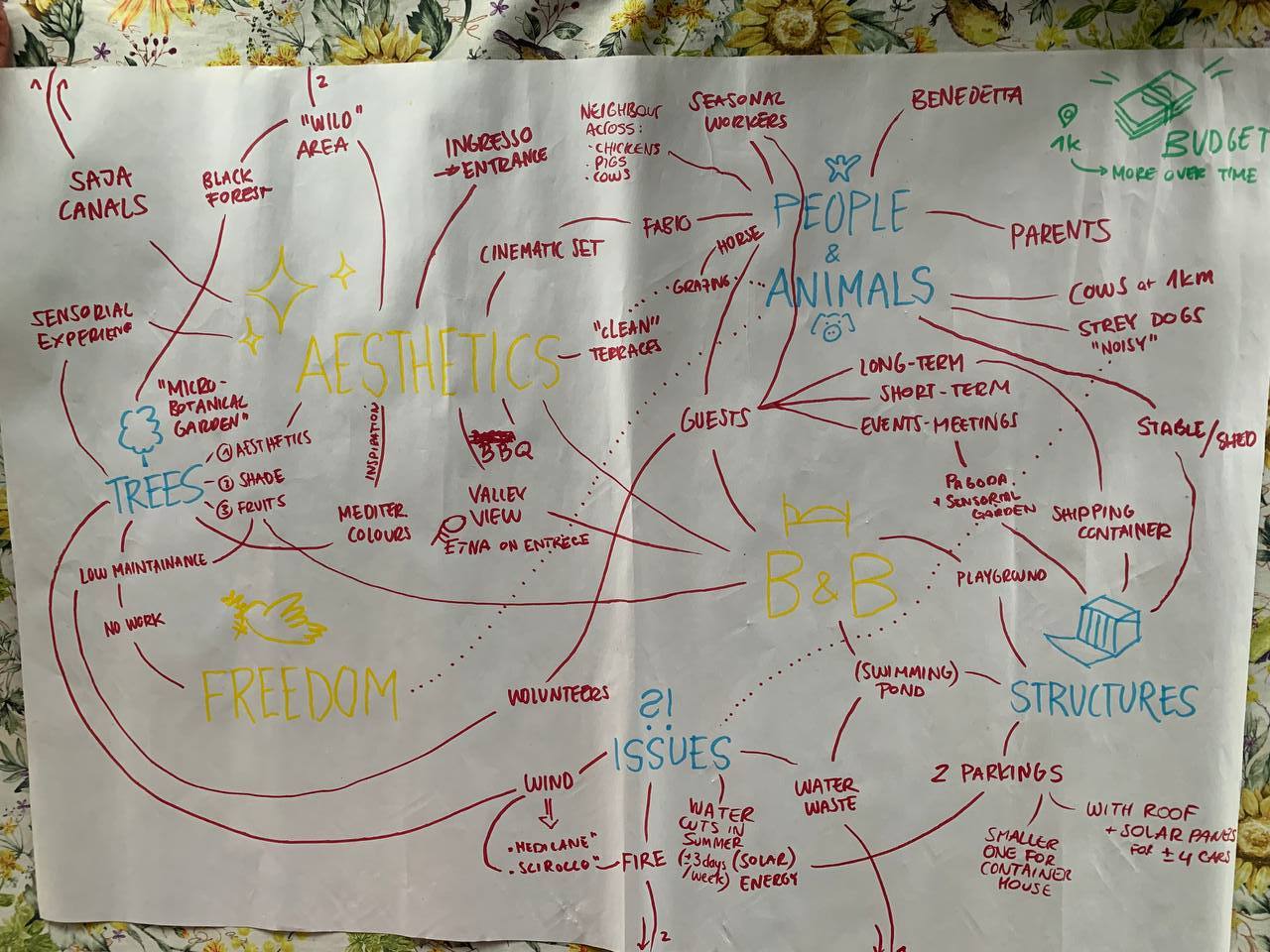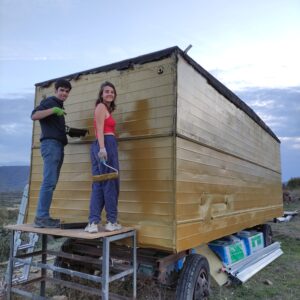Mali:
Hi dear readers,
Renzo and I are slowly getting used to Sofia’s city buzz and vibes again, after a long time of calmness in the countryside. We have been busy planning and connecting with different projects, which we want to visit for short and long-term in the coming months. Now that temperatures are beginning to drop and autumn rains fall out of the sky, my tingling fingers want to pick up my crochet needle and autumn coloured balls of wool.
This’ll have to wait a bit though, because first I want to share with you about my experiences in the permaculture design course that took place from 13 – 25 September on the beautiful island of Sicily. Our ESC project with Green School Village was paused for two weeks to avoid double funding. Vyara, Renzo and I, together with two other Bulgarians, joined an international group of 25 young people from all over Europe, for most of whom it was their first introduction to permaculture. This certified PDC in the form of a youth exchange was organized and made available for free by Saja Association as they received funding from Erasmus+. Whereas a similar course could easily cost around a 1000 euros!
Sadly there was no time given for green travel, so we had to take the plane, which in a matter of just two hours started landing and had us greeted from above by the majestic, smoking Etna.
As we arrived one day earlier to the start of the course, this gave me some time to prepare my intro session on the permaculture ethics and principles that I was going to teach during the first day. I was glad to have had the chance to test this very session in Beglika Festival a month earlier. Although, this time it was going to be a different and younger target group, so I decided to add some playful elements.
Our magical view from the guest house where we stayed all 14 days
Our first day started with an introduction from Manuela (co-organizer of the course) and Salvo (the main teacher), playing some name games and formulating our own group culture in a horizontal way. After a delicious lunch, it was time for my session. I was a bit shy at first, but needed just these first 10 minutes to get used to the 25 new eyes staring at me.
Throughout the three following hours, I felt how I unconsciously shifted away from my meticulously written out structure, and started improvising, inviting the group more to answer questions or explain certain concepts in their own way, rather than me trying to cover all that by myself. Loosening up myself, clearly also loosened up the group. After explaining the ethics briefly, I gave everyone the task to draw out on a piece of paper how they see themselves in their daily lives making decisions and integrating elements connected to these ethics of earth care, people care & fair share (see photo).
Then in pairs, everyone shared about their drawings, allowing for people to get to know each other a little better in a ‘safe’ one-to-one manner, as I felt it was a bit too early for everyone to share in front of the whole group. I wanted to build up this confidence slowly and steadily.
The next thing I shared briefly about, was the permaculture flower with the seven pedals each indicating a domain that can be approached with permaculture glasses (ethics + principles); buildings, tools & technology, education & culture, health & spiritual well-being, finances & economics, land tenure & community governance, and land & nature stewardship. Perhaps an eye-opener for some, that permaculture isn’t just about gardening! Quoting Bill Mollison (1928-2016): “permaculture is a revolution disguised as organic gardening”. 😉
From the PC flower I introduced the group to five attitudinal principles formulated by Mollison. From there I moved on to share David Holmgren’s set of 12 permaculture design principles. A long sit – so to keep the group awake, I asked them for examples and interpretations of these sometimes quite abstract formulations.
To end my session in a fun and more dynamic way, I split the group in 6 smaller groups and handed out two principle cards (thanks Vyara for making them!) to each of them. The invitation was to prepare two theatrical interpretations, in movement though without words, with the rest of the group as audience guessing which principles they represented. I gave them only 10 minutes to prepare, avoiding their playful creativity to shift too much to the overthinking mind. The result was wonderful! (see photos below)
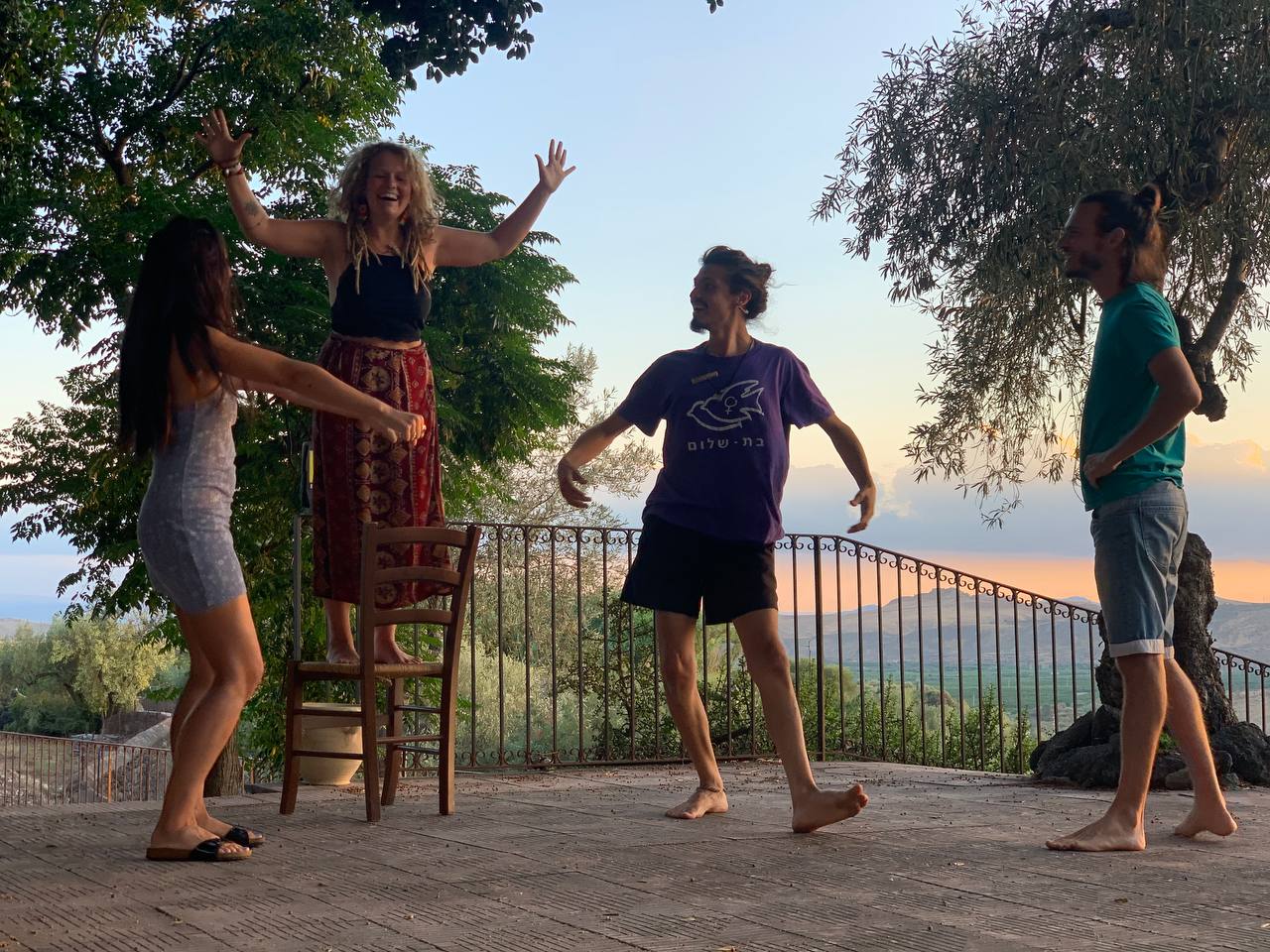
I was happy to have taken this opportunity to teach, but also felt relieved to be able to take the role as a participant again, after wrapping up my teaching session. One of my intentions in this course was to be especially observant to Salvo’s teaching styles and methods, to get some inspiration from him for my future endeavors on the PC teaching path. Over the course of two weeks, I admired his presence being so relaxed and confident in a humble way. He created an open atmosphere in which everyone was able to contribute to the sharing of knowledge and experiences, taking away the hierarchical teacher-student dynamic. Since he did his PDC in 2011, he was so blown away by what he learned there, that soon after he found himself with a piece of land where he and others joining him later on, turned this monoculture citrus plantation into a little oasis called Saja. I realised that in every class and on every topic he could bring in so much from his own experiences, mistakes and lessons learned over the course of 11 years of connecting to his land, designing a living system and being part of it himself.
Here lies the strength of a good teacher; practice what you preach before you teach!
Besides Salvo’s inspiring teaching qualities, I also gained a lot of inspiration from all of the participants who in their countries (Croatia, Bulgaria, Germany, Italy and Spain) are doing amazing things, some already owners of beautiful pieces of land or part of organisations making their sustainable dreams come true.
Doing the insightful ‘web of life’ exercise – everything is connected!
As this course was a certified 72-hours PDC, we ran through the standard topics that need to pass the revue in any PDC. So what more did we learn about: ecosystems, ecological footprint and energy, zoning and sector analysis, soil and nutrients, plants and biological elements, composting and fermentation, food production, all about the water cycle and how to harvest it, mapping exercises, food forests and agroforestry, animals in PC, wind and fire breaks, restoration, urban gardening, seeds, social and economic permaculture, doing a client interview, and most importantly, all the necessary steps that lead you to a design!
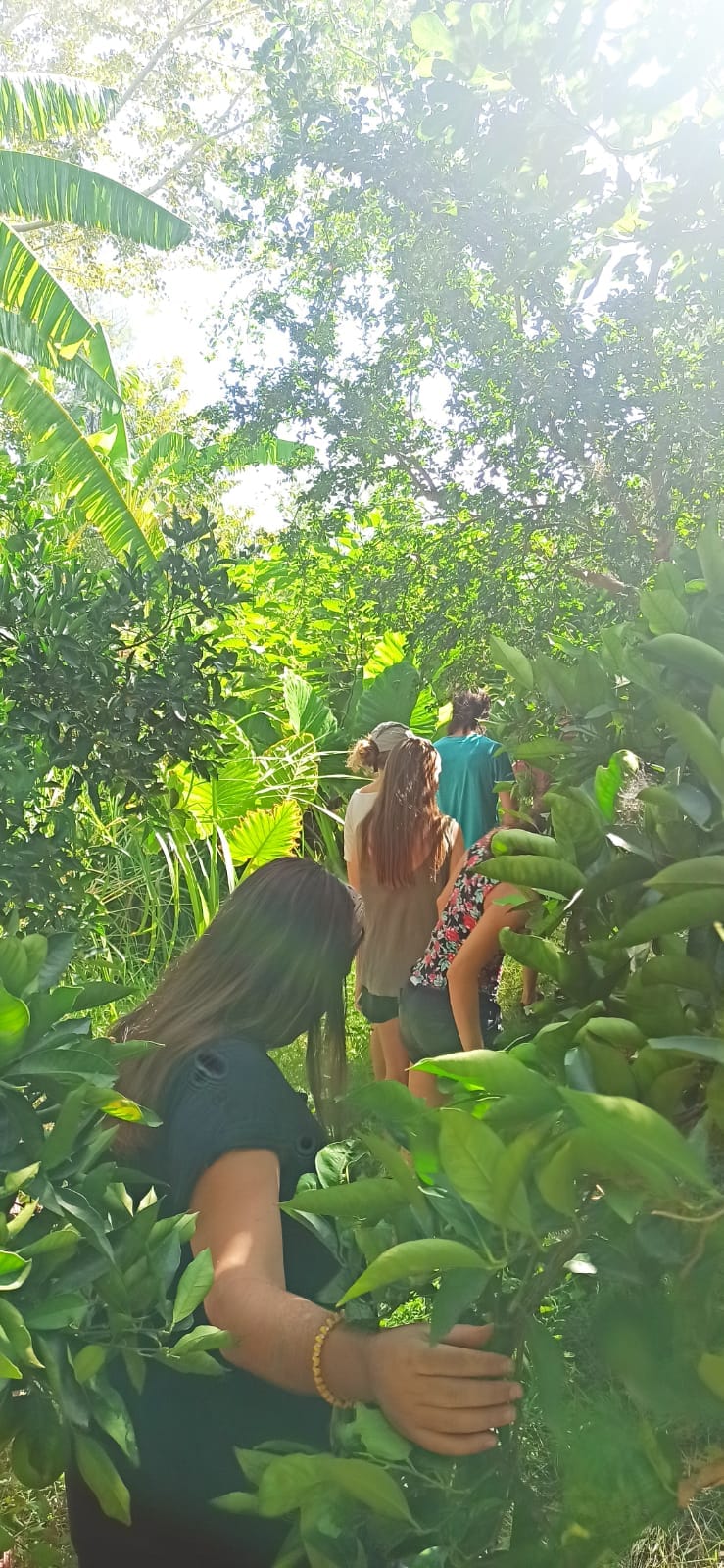
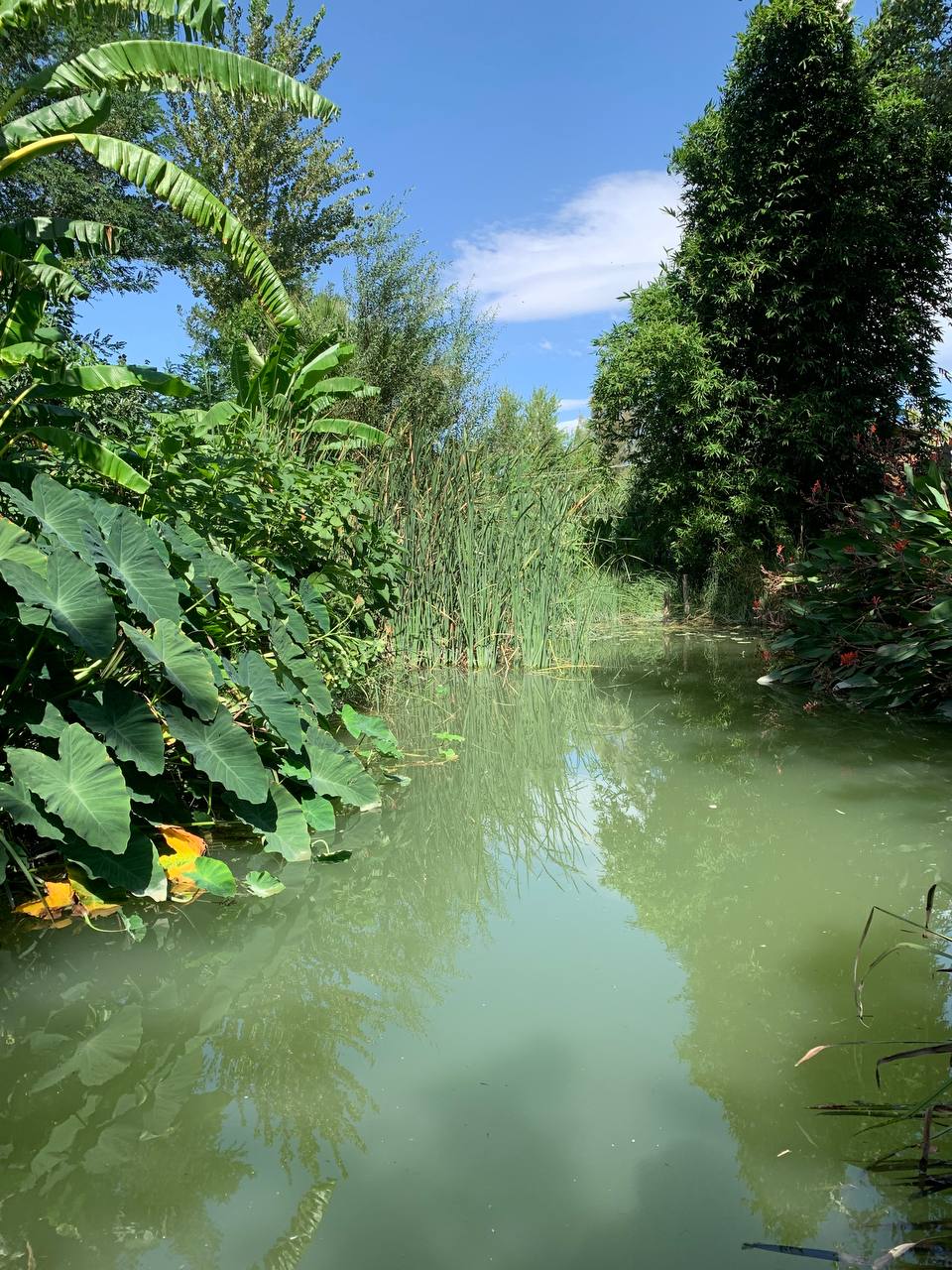
Our discovery of the oasis place Saja Project
Half way the course we went for a visit to Saja, Salvo’s paradise home. Between the banana trees and other tropical exotics, Salvo told us his project’s life story. Everyone listening in awe. He took us on a long and insightful tour, showing with pride how he had managed to build up a beautifully healthy soil, with many layers of mulch. We passed by a huge natural (swimming) pond, after zigzagging through a thick and jungle-like food forest. Later that day were given the task in smaller groups to map different parts of the land and include all the elements we encountered in this particular area, and think of the reasons why they were placed and integrated there.
When the time came to form groups and start doing our design work. I was asked by some participants to share something about dragon dreaming. I was glad to support these new groups with some inspiration of this holistic group project methodology, as passionate as I am about it 🙂 So after explaining a bit about the general framework, I guided the groups in doing a dreaming circle, where each and everyone could share their needs and wishes, to be able to look back after their two days of hard work and final presentations with a content feeling.
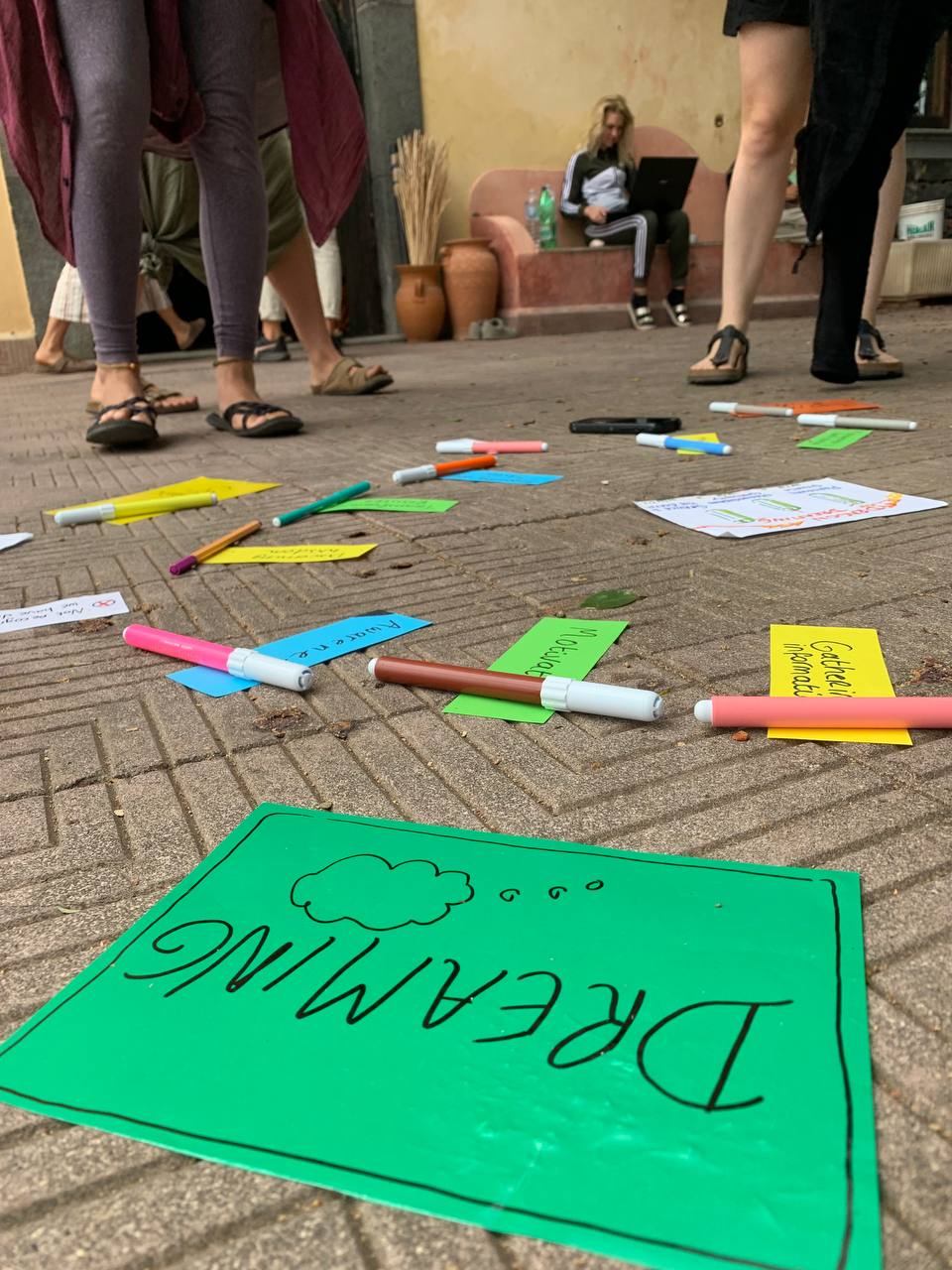
Facilitating a Dragon Dreaming session and guiding the future design work groups in doing a ‘dream circle’ to tune into everyone’s needs and wishes
The two photos below show two things that I really loved about this PDC; the place where we stayed, wasn’t doing anything with permaculture (yet), this was a great challenge and invitation to us – pioneering designers – to start the creative and analytic designing process from a place with zero design. This also meant, that the three final designs could really be used by the owner of this place. You see him below taking us on a tour and describing his dreams and visions for the land. The second photo shows a visualisation of the client interview that two participants started drawing up afterwards. I loved the fact that Salvo told the group, before we started the design work, that it is not a competition. He invited us to collaborate and help the other groups whenever we could. This created such a calm and inspiring atmosphere, celebrating rather than frustrating ourselves about people from other groups peeking over our shoulders and ‘stealing’ our ideas 🙂
Client interview tour and visualisation on paper for all groups to have it summarized well
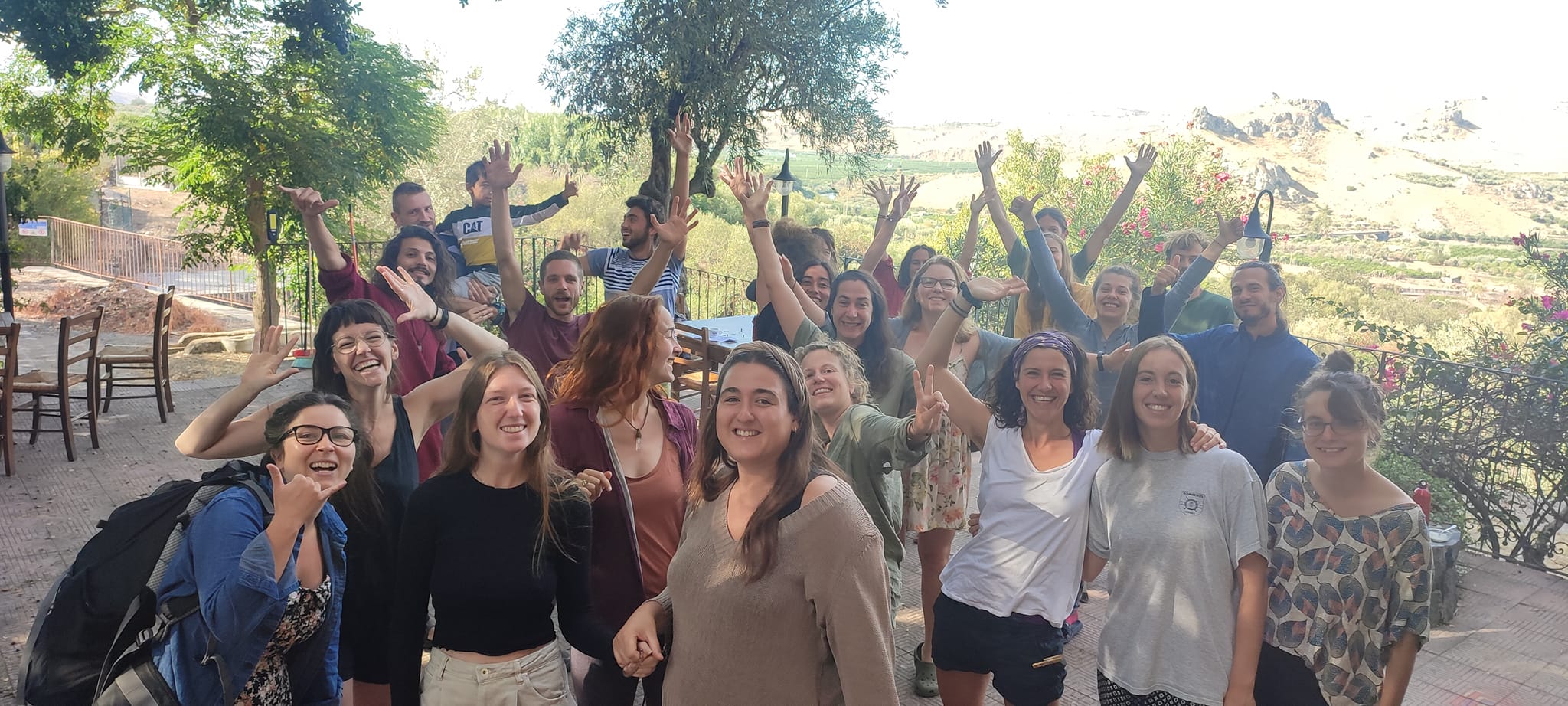
Near the village of Debnevo, there is a beautiful location of Venet’s farm: Bostan Bair. For a week, we joined some other volunteers to attend a building workshop. The garden and the landscape were amazing, and we shared a tipi tent and summer kitchen as a community. The workshop, leaded by Vasil Vranchev, aimed at converting an old van into a small cosy cabin. As much as possible, we tried to use recycled materials and the minimal means. It was a great opportunity to discover about the building process and the use of different tools. Learning by doing really works!
The first step was to remove everything from the inside of the wagon: wooden planks, polystyrene (previously used for insulation), nails, and some metallic structures. Then we fixed everything that needed to be. We replaced some of the metal sheets that made up the floor and filled holes in the floor and walls with foam. All of that leading to the most crucial part: insulation! We had two kinds of wool made out of rock and the polystyrene panels that we removed earlier. Assembling all of those was a Tetris-like brainteaser, especially when it came to do the ceiling. Before finishing the walls though, we had to install the water and electric system.
In addition, fixing the outside structure was a must. We starting by scraping off the asphalt (looking like black glue) from the entire surface. Once this was done, we had to take off the windows and door frames, which was not as easy as it sounds because some screws were rusty and impossible to take off without breaking them. We polished and painted them. We also had to straighten the metal structure all around the vagon, using hammers and plies. Then we painted the entire outside surface as well as the frames, using ocre, green and white mix (adding a dissolvant as well so the metal paint is not too thick and stays longer). In the meanwhile, we also fixed the roof as it was coming off and we needed to screw the metal parts back in.
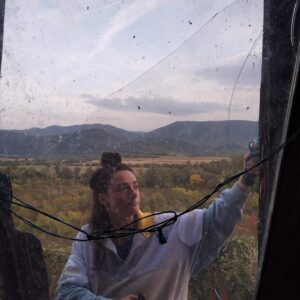
Chloé, the screwdriver master, in action (left). François and Paula making art on the exterior of the wagon (right).
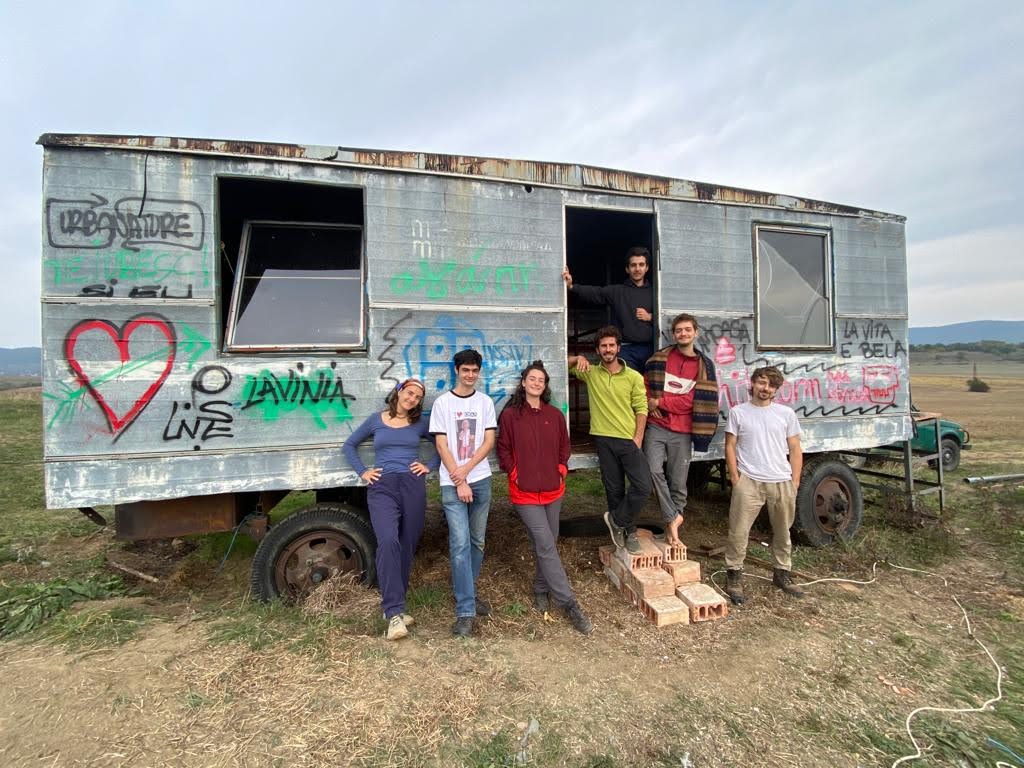
This was my first permaculture course, a wonderful experience full of meetings, talks, knowledge exchange and debates. With people from all over Europe, sharing two weeks all together from breakfast to dinner was an experience I will always remember.
I would like to mention that I am happy that the possibility of a free PDC course like this was opened. Sometimes there is a lot of desire and talent but little means…
Every day was very long, full of learning and insightful classes. In one of them we carried out an activity during the visit to Saja, the permaculture project of our teacher, which I wanted to share with you. I wrote it down in a step by step session-format to add to the permaculture teaching materials of the Bulgarian Permaculture Association, but it can also be used by anyone else! Click here to open the PDF: Session Connecting with Zones 🙂
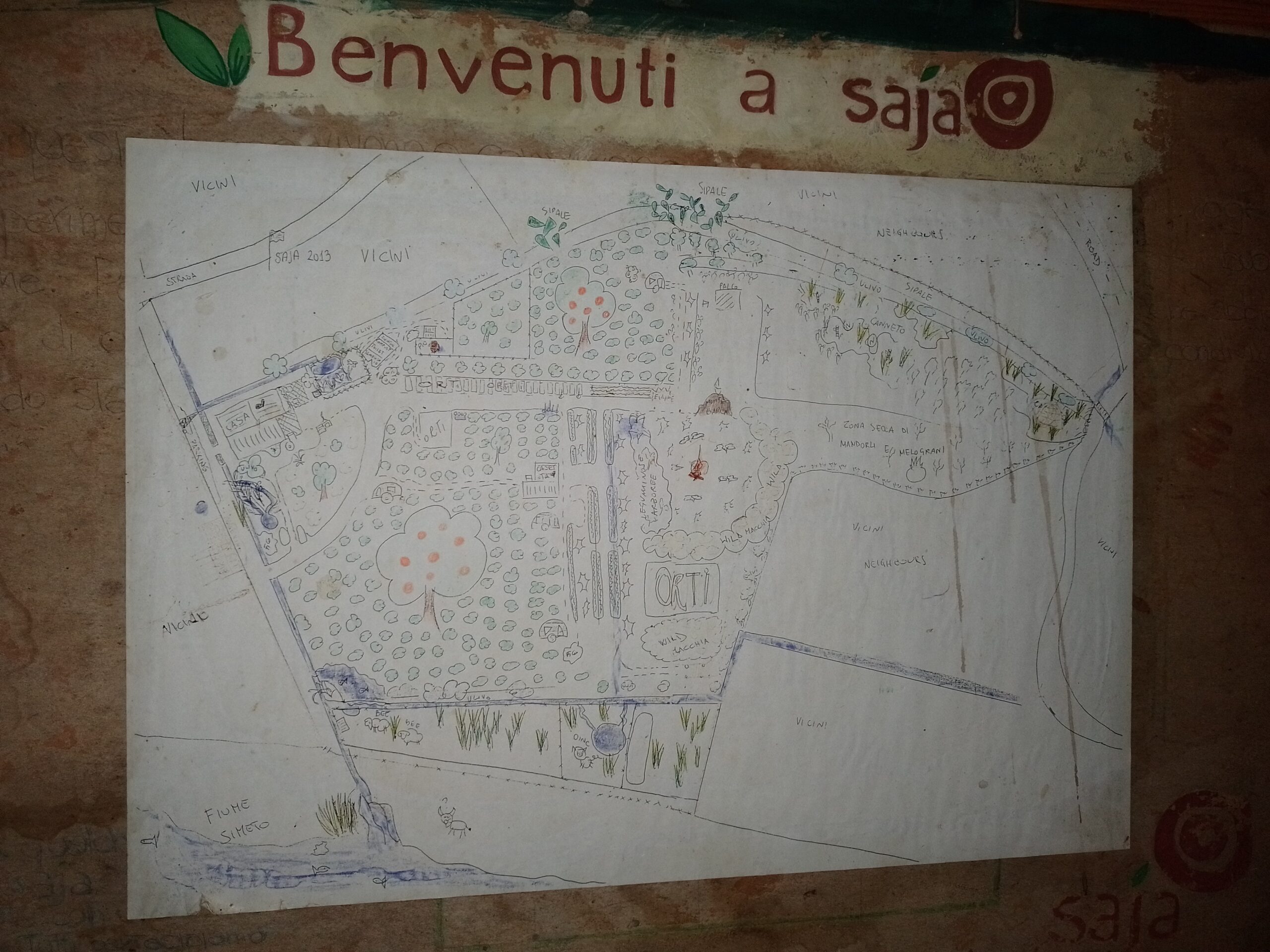
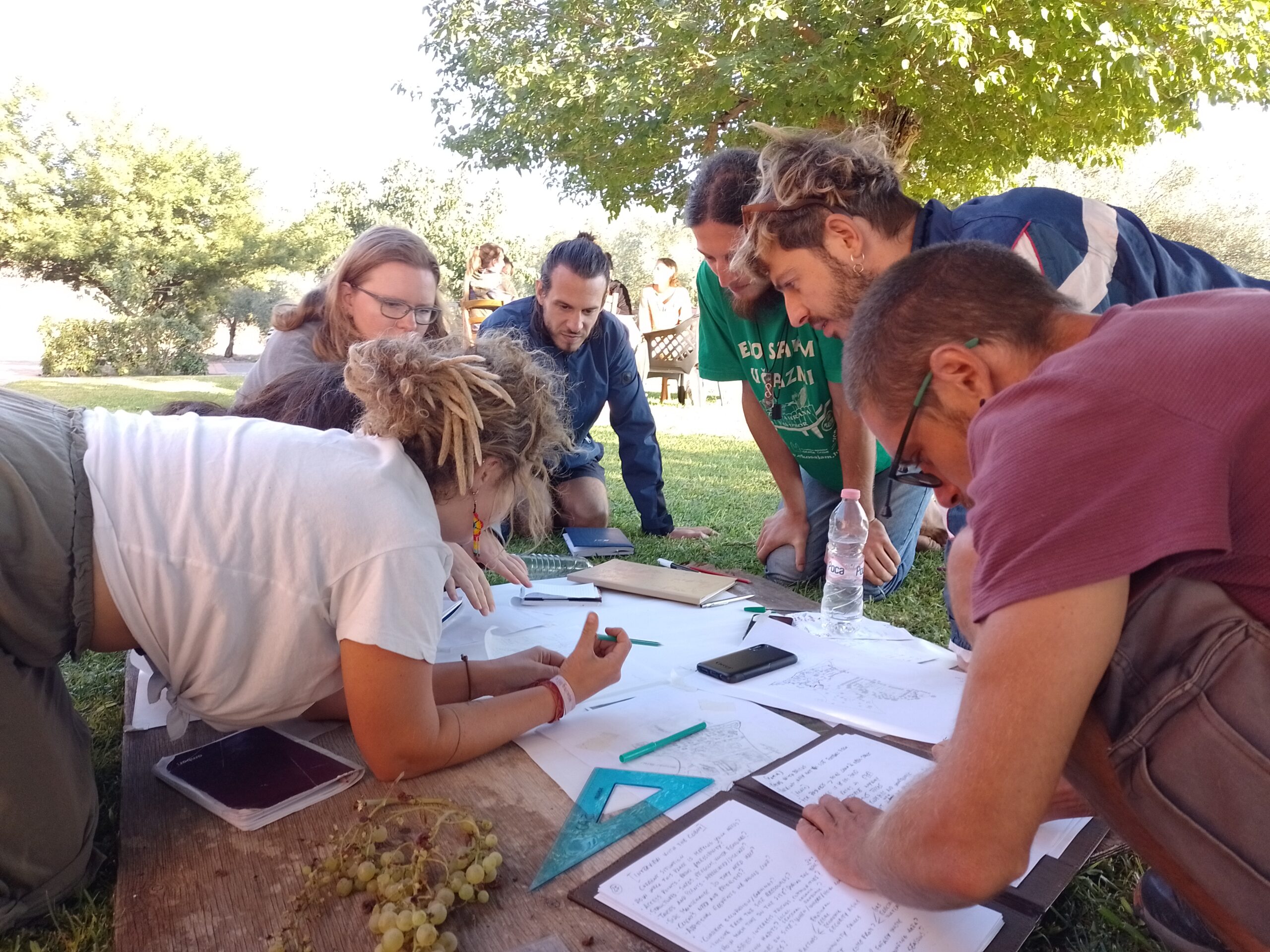
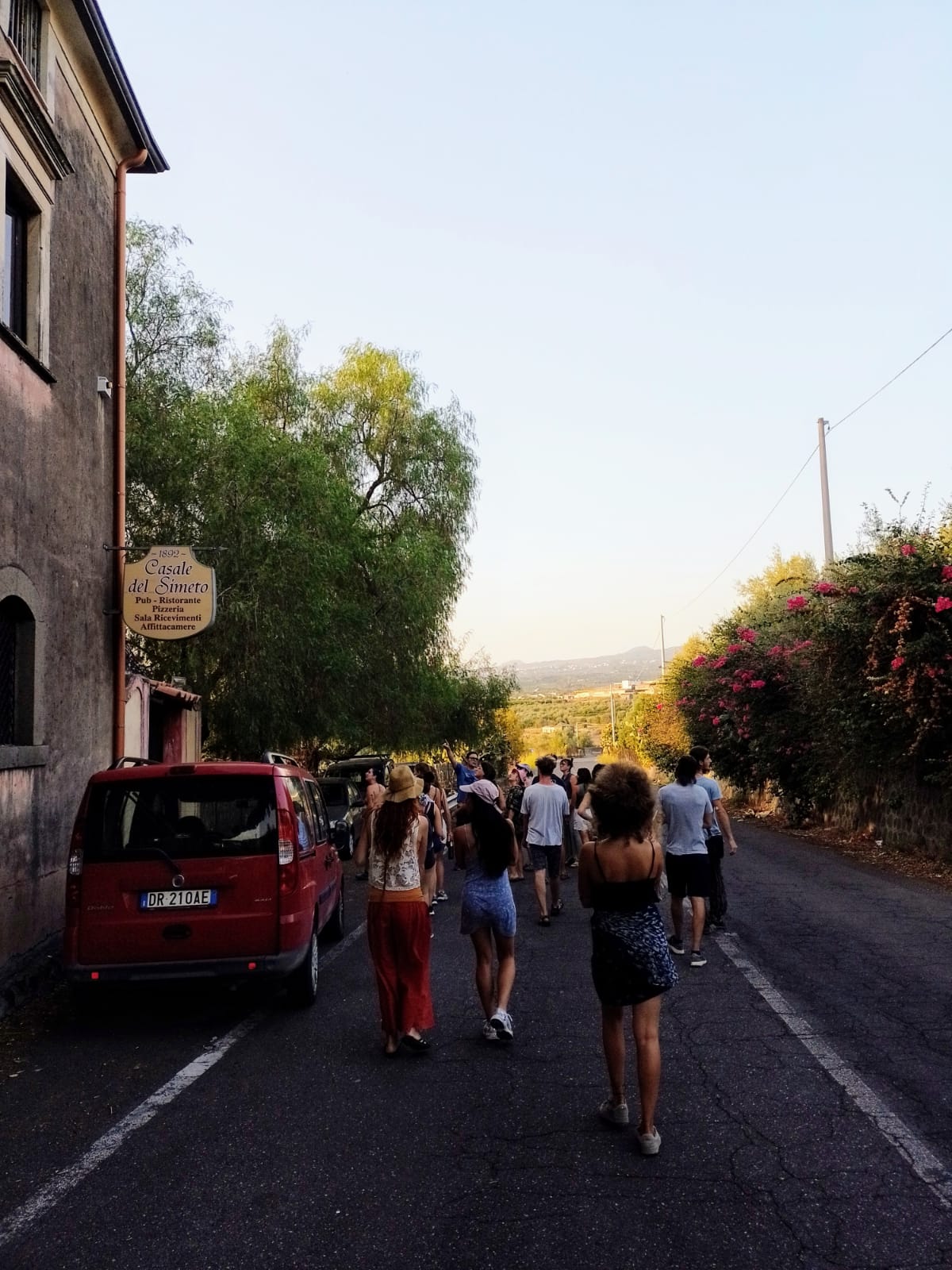
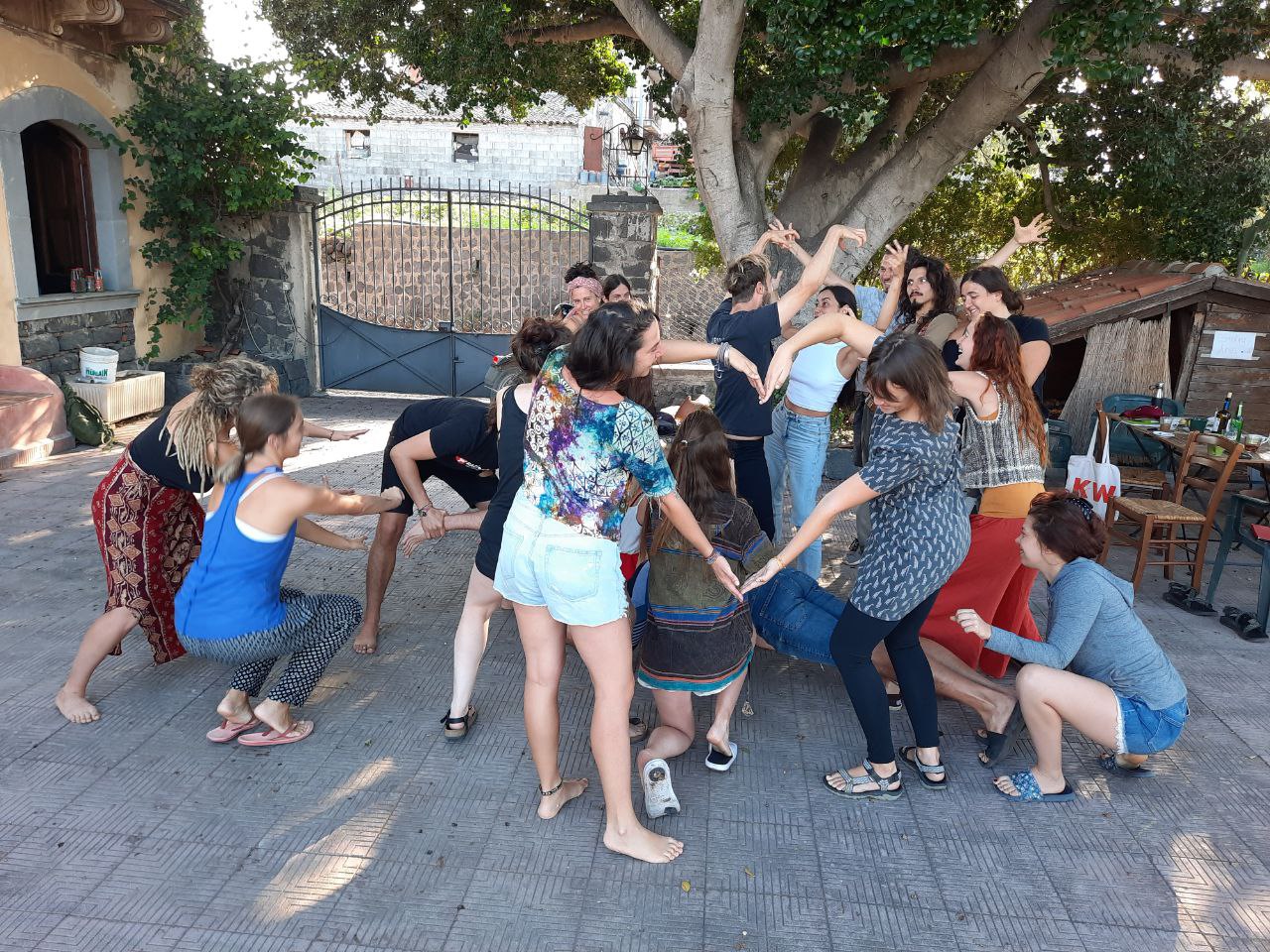
There is still so much information and lessons to process and integrate in my life. So maybe in one of the future blogs I might share another teaching session that inspired me in this course. Now it’s time to focus again on the ESC project in Bulgaria and see how I can support the farms we will visit with my new knowledge 🙂
Ciao!!



